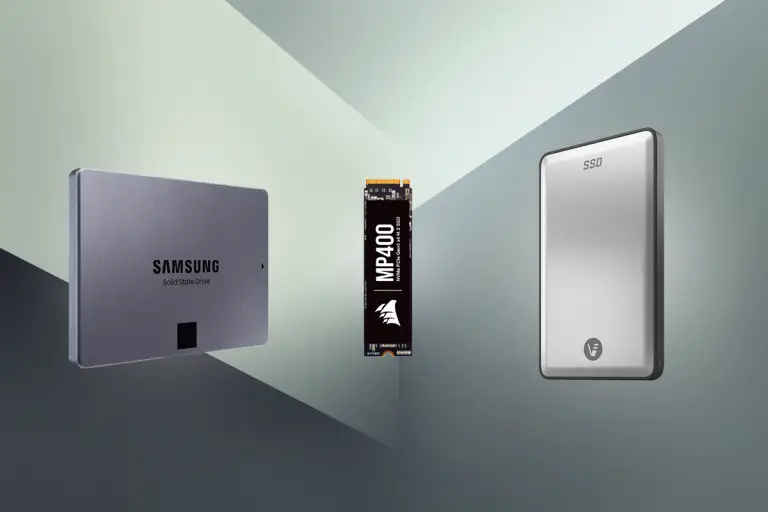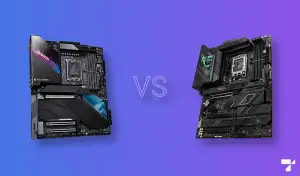Solid-state drives are the most popular storage devices today. Putting one in your system can instantly reduce boot times, launch apps and games faster, and improve performance in applications like video editing that heavily rely on a storage device’s speed.
Today SSDs are found in almost all systems, even budget ones. However, until recently, there weren’t many large capacity SDDs options for those that require extra storage capacity. However, with the introduction of QLC or Quad Layered Cell flash, quite a few SSDs are now available in 8GB configurations.
Therefore, in this article, we have provided a comprehensive guide containing the best 8TB SSDs. We have also included the top M.2 NVMe, SATA, and external 8TB SSD variations for you to choose the storage option that best fits your needs and budget.
Best 8TB M.2 NVMe SSDs
1. Sabrent Rocket Q 8TB NVMe M.2 SSD
Specifications:
Capacity: 500GB, 1TB, 2TB, 4TB, 8TB | Controller: Phison PS5012-E12S-32 | Memory: Micron 96L 3D QLC | Interface: M.2 PCIe 3.0 x4, NVMe 1.3 | Sequential read: 3,300MB/s (8TB version) | Sequential write: 2,900MB/s (8TB version)Features:
- Phison E12S NVMe controller for fat PCIe 3.0 speeds
- Sabrent Acronis True Image cloning software included for free
- Five-year warranty (Registration required)
Sabrent was one of the first manufacturers to produce an 8TB NVMe SSD in the M.2 2280 size. This small form factor enables the Rocket Q to fit quite easily into the M.2 slot of a supported notebook, reducing the need for a hard drive that is bulky and extremely slow. Since the Rocket Q is an NVMe SSD, it will put out speeds of up to 3,300 MB/s read, and 2,900 MB/s write.
However, keep in mind that due to the limitations of the QLC flash in the SSD, you will see significant throttling in transfer speeds when you fill the drive up. Compared to other alternatives like SATA SSDs and HDDs, which are slow, to begin with, it seems to be a good bargain. The Rocket Q also suffers from a lower write endurance of only 1,800 TB for the 8TB capacity, another disadvantage of its QLC flash.
The SSD runs on the Phison E12S controller that supports the PCIe 3.0 standard. With PCIe 4.0 being the new standard, we expect the newer 8TB SSDs to come with better quality TLC flash that is faster and does not throttle. The Micron 96L QLC NAND flash is the main reason why the Rocket Q can achieve an 8TB capacity.
Sabrent decided to include a free cloning software, Acronis True Image, that is handy if you’re looking to upgrade from an existing storage device. A one-year warranty comes included with the SSD, and you can increase it up to five years by registering the device within 90 days of purchase.
Although the QLC flash has its limitations compared to other SSDs that employ TLC, the 8TB capacity is enough to warrant you picking up the Rocket Q. It offers an excellent price-per-GB for an NVMe SSD, and for $1,299.99, the SSD is undoubtedly expensive, even more than many laptops, but offers a large amount of fast storage in both a light and tiny package.
2. Corsair MP400 8TB NVMe PCIe M.2 SSD
Specifications:
Capacity: 1TB, 2TB, 4TB, 8TB | Controller: Phison PS5012-E12S-32 | Memory: Micron 96L 3D QLC | Interface: M.2 PCIe 3.0 x4, NVMe 1.3 | Sequential read: 3,480MB/s (8TB version) | Sequential write: 3,000MB/s (8TB version)Features:
- CORSAIR SSD Toolbox software makes tasks like firmware updates easier
- Five-year warranty included
- Endurance of up to 1,600 TB written
The Corsair MP400 is a relatively new high-capacity SSD that comes in the M.2 2280 size. It offers a marginal performance improvement over the 8TB variant of the Sabrent Rocket Q, which comes at the cost of decreased endurance, sitting right at the 1,600TB mark. The MP400 employs a QLC flash identical to the one used on the Rocket Q.
The SSD’s read speed stands at 3,480MB/s, while the write speed is 3,000MB/s, which will begin to throttle as it fills up. Most QLC-based SSDs typically use about one-fourth of their capacity as an SLC cache for the rest of the drive, which shrinks as more data is written, reducing speed significantly. But in the case of an 8TB SSD, this substantially decreases as the space available is pretty large.
The drive utilizes the Phison E12S PCIe 3.0 controller. Although newer drives with PCIe 4.0 arrive with the newer Phison E16 and E18 controllers. But unless these SSDs use TLC, the QLC flash will still be a limiting factor in speed.
The Corsair MP400’s higher price tag at $1,498 is only worth it if you’re planning on going with the 8TB SSD, as the time is taken to populate the initial SLC cache will be substantially longer. With SSDs frequently going out of stock, it’s also a great alternative to the Sabrent Rocket Q.
Best 8TB SATA SSDs
SAMSUNG 870 QVO
Specifications:
Capacity: 1TB, 2TB, 4TB, 8TB | Controller: Samsung MKX | Memory: Samsung 92L 3D QLC | Interface: 2.5-inch SATA | Sequential read: 560MB/s (8TB version) | Sequential write: 530MB/s (8TB version)Features:
- 2.5-inch slot factor is widely supported
- Samsung Magician software included
- 3-year warranty
Samsung was one of the first manufacturers to embrace QLC, back when they released the 860 QVO. Their newer 870 QVO utilizes the second generation of Samsung’s QLC NAND and is the first-ever SATA SSD to launch with an 8TB capacity. This time, Samsung decided to develop the 870 QVO to target the 8TB SSD market instead of marketing it as a cheaper, low-capacity alternative. The SSD utilizes an in-house controller with a DRAM cache and error-correcting algorithms to make up for QLC’s shortcomings.
Going with anything less than 4TB with the 870 QVO will turn out to be a bad value as even TLC-based SATA SSDs without a powerful controller and DRAM cache will perform better in durability and transfer speeds. The main reason for QLC is that it makes 8TB a possibility and reduces the price-per-GB significantly to make it a worthwhile consideration.
The 870 QVO’s write speed comes in at 530MB/s, while the read speed is set at a slightly higher 560MB/s. The write endurance of the SSD is rated at 2,880 TB, much higher than the QLC NVMe SSDs we saw earlier. The high capacity of the 870 QVO and its 2.5-inch form factor makes it the ideal choice for replacing your existing high-capacity hard drives, as the performance gains will be pretty significant than even the fastest ones.
The $899.99 price tag of the 870 QVO places it in an ideal spot for buyers to consider it over the more expensive NVMe 8TB SSDs. If you’re looking to migrate to something much faster than HDDs while having a high endurance and lower price, the 870 QVO is just right for you.
Best 8TB External SSDs
1. Sabrent Rocket XTRM-Q
Specifications:
Capacity: 500GB, 1TB, 2TB, 4TB, 8TB | Controller: Intel JHL7440 (Titan Ridge) + Phison PS5012-E12S-32 | Memory: Micron 96L 3D QLC | Interface: USB 3.2 Gen 2, Thunderbolt 3 Type-C | Sequential read: 2,700MB/s (8TB version) | Sequential write: 2,700MB/s (8TB version)Features:
- Durable construction made of solid Aluminum
- An in-built temperature monitoring system
- Automatically detects Thunderbolt and USB connections
If you need an NVMe SSD for your workflow, but your primary device lacks support for an M.2 SSD, then the best alternative is to go with an external SSD. These are equally fast, with reading and write speeds of up to 2,700 MB/s, just a 20% drop off from the typical NVMe SSDs. However, to fully utilize these speeds, it’s essential to have a Thunderbolt 3-supported host device.
A unique characteristic of the Rocket XTRM-Q is switching between Thunderbolt and USB 3 depending on the host device. Many Thunderbolt-capable drives will simply refuse to connect via USB, but thanks to the Titan Ridge controller, the XTRM-Q can be used for easy file transfer between devices.
The external SSD makes use of Sabrent’s Rocket Q NVMe SSD on the inside, though it’s pretty much sealed shut, so don’t expect to upgrade the drive in the future. The NVMe SSD allows the XTRM-Q to easily fit in the palm of your hand, making it an ideal accessory for those frequently on the go. Sabrent also includes a Thunderbolt cable with the SSD.
At $1,399.99, the Rocket XTRM-Q is a bit more expensive than the barebone Rocket Q SSD but offers plug and play alternative that is great if your device has Thunderbolt 3 but lacks an internal slot for NVMe SSDs. USB 3 functionality also lets you connect it to regular devices for a versatile storage solution.
2. Oyen Digital U32 Shadow
Specifications:
Capacity: 500GB, 1TB, 2TB, 4TB, 8TB | Controller: ASMedia 235CM | Memory: Samsung 92L 3D QLC | Interface: USB-C (3.1 Gen 2 10Gbps) | Sequential read: 550MB/s (8TB version) | Sequential write: 550MB/s (8TB version)Features:
- Sleek aluminum housing
- 3-year warranty
- Padded carrying case included
An external NVMe SSD is excellent if you can utilize its speed to improve your workflow, but these SSDs fall behind what SATA SSDs can offer when it comes to price and endurance. The Oyen Digital U32 Shadow is an example of a well-built SATA SSD that is a great storage medium for those who need a fast and reliable way to transfer their data between devices.
The U32 Shadow supports USB 3.1 Gen 2, over which you can transfer data at a maximum speed of 550MB/s. The drive uses an ASMedia 235CM controller that supports the UASP protocol and TRIM functionality. While many external SSD manufacturers prefer to leave out the SSD specification used on the inside, we have little reason not to believe the U32 Shadow uses the 870 QVO from Samsung.
The SSD is well built with a durable aluminum chassis that does not include anti-shock protective coverings, though you can get a version of the SSD that includes it. The Slate Grey finish is prone to scratches, so make sure to carry the drive in the included padded carrying case. The SSD also comes included with USB C-to-C and USB C-to-A cables.
At $1,199.00, the U32 Shadow makes sense only if you are strictly on a budget and need a SATA SSD endurance. For $200 more, NVMe SSDs like the Sabrent Rocket XTRM-Q offer much faster speeds in a smaller form factor, so do consider that before purchasing.
3. VectoTech Rapid
Specifications:
Capacity: 1TB, 2TB, 4TB, 8TB | Controller: Silicon Motion SM2258G | Memory: Micron 96L 3D QLC | Interface: USB 3.1 Gen 2 | Sequential read: 540MB/s (8TB version) | Sequential write: 540MB/s (8TB version)Features:
- Premium and durable aluminum build
- 3-year manufacturer warranty
- Vibration and shock-resistant
The VectoTech Rapid is another external 8TB SSD that utilizes a SATA SSD in a custom enclosure that takes up very little space and is light enough to be carried around without hassle. It also uses a USB 3.1 Gen 2 interface for data transfer, which we believe a majority of the devices manufactured support today.
The drive’s 540 MB/s transfer rate is what one would expect from a SATA-based SSD, which, although much slower than NVMe, is way more enduring. Based on our findings, the drive inside seems to be a Micron 5210 Ion SSD, which has a similar data transfer rate as the Rapid.
The Rapid features a minimal and well-built aluminum housing with sides that are made of ABS plastic. Although there is no mention of any shock and vibration-resistant material, VectoTech claims that the SSD can handle rough conditions due to the lack of mechanical parts.
For $1,139.00, the VectoTech rapid is a good deal for a SATA external SSD. We recommend paying a bit extra for NVMe SSDs as they have much higher read and write speeds, though they require a Thunderbolt 3-enabled device for best results.
NVMe VS. SATA SSDs
If you’re new to the landscape of SSDs, it can seem challenging to differentiate between the different types available in the market. All SSDs available today essentially use the same basic technology to store data in the form of an electrical charge. SSDs typically use a cell structure to store bits of data. A typical TLC flash SSD stores three bits of data, while QLC flash will store four bits.
Storing a larger amount of bits per cell is great for increasing SSD capacity but significantly reduces the drive’s endurance and write performance due to the larger amount of data being written per cell. To counter this, manufacturers will allocate a fraction (typically 1/4th) of the SSD to function as an SLC flash-based cache. However, on reaching the end of the SSDs limit, the cache is significantly reduced to free up space degrading the performance.
NVMe Is Faster than SATA
SATA and NVMe SSDs both employ the same QLC flash structure as mentioned. The only difference between the two is the interface used to transfer data between the drive and host. NVMe is much faster, typically at higher transfer rates than SATA SSDs.
Not All M.2 SDDs Are NVMe, Some Are SATA
NVMe SSDs will almost always be sold in an M.2 form factor, which you can quickly identify through their small size, similar to a stick of gum. The small form factor makes it extremely easy to use this drive in portable devices like laptops. Not all M.2 drives are NVMe. Some SATA drives like this Samsung 860 EVO are sold in the M.2 form factor and will be much slower than NVMe SSDs.
Typical SATA drives come in the 2.5-inch form factor similar to hard disks but is way lighter and faster in data transfer. We recommend SATA SSDs if you plan on migrating to a more rapid form of storage from existing hard drives. SATA SSDs are also cheaper than NVMe SSDs, but at 8TB, the difference is not much, so endurance should be the main factor you consider.
Final Thoughts
We hope you learned about the types of SSDs available in the market today. It is essential to make the right decision between NVMe and SATA SSDs based on your use case. If the devices you use lack support for an internal SSD, you can go through our list of external 8TB SSDs to help you with your decision.



